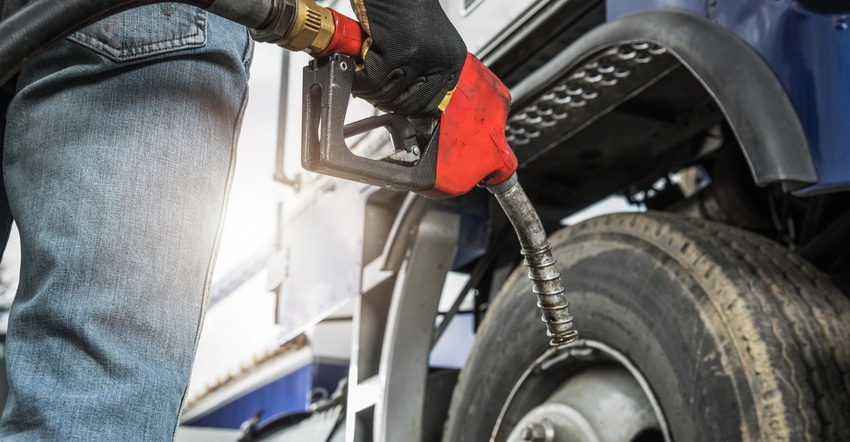
Some Kansas farmers have returned the combines to the shed as they’ve wrapped up wheat harvest. They’re now looking ahead to their summer and fall fuel use in an environment of high fuel prices.
Kansas State University agricultural economist Gregg Ibendahl says to be prepared for continued higher prices. Ibendahl spoke on a webinar June 22.
Fuel prices
“Anyone who’s been filling up their pickup truck or car knows we’re paying much higher prices than we were last year,” Ibendahl said. But, those high prices started their rise back at the beginning of 2021. The price of highway diesel and highway gasoline have more than doubled in the time frame, but he said about 50% to 60% of that increase came before the Russian invasion of Ukraine.
Low inventories, especially of diesel fuel, have the price spread between diesel and gasoline widening from 25 to 30 cents to now more than $1, he said. The Energy Information Association predicted that once refineries recovered from their regular early-spring maintenance, which typically drops capacity, that gap would go away and diesel prices would go down again.
“It turns out that diesel prices have kind of stayed high, and we’ve seen gasoline prices actually go up even higher here,” Ibendahl said. The EIA now predicts that going into the fall, Americans will still be paying a bigger-than-normal difference between diesel and gas, which will affect farmers trying to get their fall crops harvested. Ibendahl said the situation is likely to persist on into 2023.
At the start of the Russian invasion there was more price volatility — simply because traders had no idea what the effect of removing Russian oil would have on global markets. But since, traders have seemed to settle on the idea of $120 to $125 a barrel for oil, he said. And using a regression model, he expects $120 oil to produce a highway diesel price of about $4.60 or so a gallon, and highway gasoline to be about $4.25.
So why are we paying more than that at the pump?
Other factors
Ibendahl said you can’t blame high fuel prices entirely on the Russian invasion.
First, the EIA refined product crack spread shows that refiners are earning very good margins of somewhere in the neighborhood of $1.50 to $2 per gallon in June 2022. Ibendahl said that’s due to refinery capacity and utilization, which has steadily decreased over the last year.
COVID-19 reduced demand for diesel and gas starting in 2020, and that mean underperforming or damaged refineries were taken offline. Ibendahl said current U.S. oil refineries are in poor condition, and are not as efficient as they could be.
“The last refinery built in the U.S. was, I think, in 1977,” he said. Hurricanes in the Gulf have taken their toll on refineries. And the regulatory hurdles for new construction are discouraging as well.
Russian sanctions
When Russia invaded Ukraine in March, the U.S. and the world responded with sanctions on many Russian goods, including oil, gas and fertilizers. However, Ibendahl emphasized that oil, gas, and fertilizers are all fungible commodities and are notoriously difficult to sanction.
“So, even though we say we’re going to block them one way, those things are just like water going through a pipe,” he said. They will find a way out of the country to buyers who are willing to pay more and look the other way, such as India and China — as long as they have the infrastructure to produce fertilizers and fuel from oil, and then get those products to a port for shipping.
Ibendahl made the argument that sanctions aren’t working to the extent the world expected. Back in March, at the beginning of the Russian invasion, the value of the ruble initially dropped. But now, it’s the strongest it’s been in more than five years, he says. Interest rates are down to 9.5% from highs of 20% set by the Russian central bank — back not too far off from where they were at the start of the war, he said. Overall, the Russian economy is expected to contract, but less than initially predicted, Ibendahl added.
“One thing Russia did that was really smart on their part, I think helped them out, was they actually require buyers of natural gas and other commodities to buy at least 80% of that in rubles, and since backed that down to 50%,” Ibendahl said.
What the sanctions are accomplishing, though, is really limiting the amount of goods that are going into Russia from other countries, which is hurting the Russian people more than the Russian government, he added.
Ibendahl said ultimately the cure for $5 gas is $5 gas — meaning high gas prices could make consumers drastically curb their use and demand would fall, leading to lower prices. But for now, the U.S. is still in a period of consumers wanting to travel because of that pent-up demand from the pandemic.
To watch Ibendahl’s full presentation, visit agmanager.info.
About the Author(s)
You May Also Like






